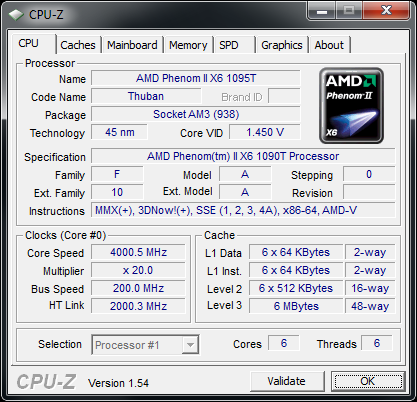Phenom II X6, 4GHz and Beyond in 64-bit OSes
by Anand Lal Shimpi on April 27, 2010 12:17 PM EST- Posted in
- CPUs
- AMD
- Phenom II X6
In most of my CPU reviews I tend to focus on light overclocking - the low hanging fruit if you will. Over the past few years the focus has shifted from absolute performance to performance per watt. An overclock stops being so interesting if you have to incur a huge power penalty to get there. That's the reason I've put more emphasis on stock voltage overclocks in the past few years.
The fact that I was able to get my Phenom II X6 1090T running at 3.8GHz with minimal effort was very impressive in my opinion. Remember that unlike Gulftown, AMD didn't get the benefit of a process shrink with the Phenom II X6. Six cores and nearly a billion transistors running at 3.8GHz with less than 10% more core voltage is awesome. But you all wanted more:

The most I could get out of the X6, reliably with air cooling, was 4GHz. It required more voltage than 3.8GHz but it's doable. The other important takeaway? It was fully stable in a 64-bit OS. In the past we've had issues with AMD's processors and ~4GHz overclocks in 64-bit Windows, but Thuban appears to have fixed that. I'm able to get into Windows at 4.1GHz but not what I would consider stable.
Note that at 4GHz the Phenom II X6 is faster than a Core i7 975 in our x264 encoding test.










33 Comments
View All Comments
Pirks - Tuesday, April 27, 2010 - link
Nice to see fat blue ass thoroughly violated by green guys, haven't seen such exemplary Intel pwning for looong time. Now if only AMD could do the same in mobile CPU segment and replace their POS Turions with something competitive. *sighs*Hacp - Tuesday, April 27, 2010 - link
Dear Pirks,AMD actually has really good Turions out right now if you buy the 45nm models. The one caveat is that their GPU solution stinks and generally you need to underclock the GPU to get decent heat/battery life.
KaarlisK - Tuesday, April 27, 2010 - link
Could you provide a link on the underclocking you mention? Would be very interesting to me, thanks :)And yes, it is definitely time for a 45nm Turion II review on Anandtech.
Hacp - Saturday, May 1, 2010 - link
Try K10stat or any other underclocking software.Makaveli - Tuesday, April 27, 2010 - link
lol where do you see pwning?I see a really good chip for $300 that overclocks well, however it only comes close when doing thread heavy stuff.
If I was running an AM3 board I would purchase it in a heartbeat no doubt, but this is no i7 killer!
02J - Tuesday, April 27, 2010 - link
The 1090T averages 96.5% of the performance of the the 920 across the all the tests in the Anandtech bench. When it wins, it does so by an average of 8%. When it loses it does so by an average of 12%. The LGA 1366 platform averages twice the cost of AM3 and implements.I think those stats would generally qualify as close in terms of pure performance, definitely in terms of value.
TekDemon - Friday, May 14, 2010 - link
I wasn't aware that having 96.5% of the speed of a now-discontinued Intel CPU that was the very slowest in the entire i7 lineup was "pwning" anything. Not to mention that the 1090T doesn't really offer any cost savings like you claim...in fact it usually costs more money than the i7 930, let alone when the 920's were selling for $199.Griswold - Wednesday, April 28, 2010 - link
If you buy a 4 or 6 core processor and do not intend to do "thread heavy stuff", you're an idiot. Its the purpose of this CPU to do just that. Simple.godl!ke - Tuesday, April 27, 2010 - link
I'm glad that you're supporting the underdog here (i.e. AMD) but summarily dismissing Intel's current offerings makes me think you're somewhat biased. The way I see it, AMD is in no way "pwning" Intel with these processors.The bottom line is that people should strongly consider what their priorities are before they make their purchases. When you make that If content creation and multi-tasking are your priorities then AMD is the best choice. If price is a limiting factor then obviously AMD again is best. For many however, games and single-threaded apps are most important, and for them Intels offerings are the most suitable choice.
Personally, I don't mind if my MPEG's or MP3's take an extra 5 minutes to encode. I'd prefer to have the extra 5+ fps in games. There is no runaway winner here.
02J - Tuesday, April 27, 2010 - link
I absolutely agree with your point that intelligent choices should be made based on one's own real world usage rather than benchmarks which are designed to expose and exaggerate differences that often would n't even be noticeable in typical use.I think opting for Intel for a 5 FPS advantage, or 8 or 15 for that matter would be a questionable decision for a couple of reasons.
1) The money saved with AMD over Intel could likely be used to raise the tier of video card used and provide a larger overall benefit.
2) The benefit in any case is something that potentially can't even be observed as most mid to upper range offering on either side couple with a video card of the same caliber can produce more than the many monitors can even display at typical resolutions.